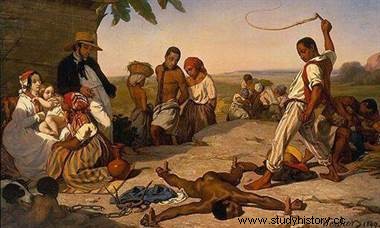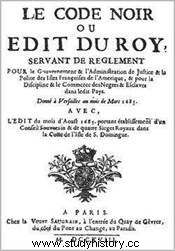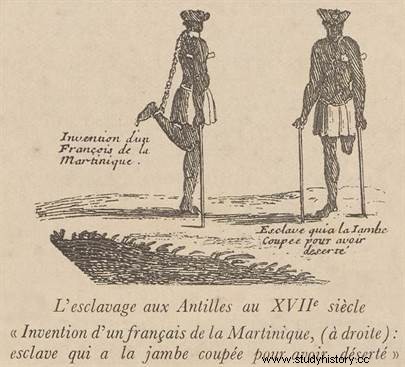 Seen as the symbol of the Atlantic slave trade and slavery practiced by France, the Code black (or "slave policing edict" ), compiled by Colbert and which includes sixty articles, aimed to establish the legal status of slaves in the French West Indies. It was promulgated in 1685, the same year as the revocation of the Edict of Nantes, under the reign of Louis XIV, two years after Colbert's death. Other texts inspired by it will be added for other colonies, and we should therefore rather speak of Black Codes.
Seen as the symbol of the Atlantic slave trade and slavery practiced by France, the Code black (or "slave policing edict" ), compiled by Colbert and which includes sixty articles, aimed to establish the legal status of slaves in the French West Indies. It was promulgated in 1685, the same year as the revocation of the Edict of Nantes, under the reign of Louis XIV, two years after Colbert's death. Other texts inspired by it will be added for other colonies, and we should therefore rather speak of Black Codes.
The context of the Code Noir
It was mainly in the first half of the 17th century that France entered the slave trade and began to use slaves massively for plantations in its West Indian colonies. It is then in competition with its European rivals, such as Spain or the Netherlands, but especially England. The main issue is the cultivation of sugar cane. The Code Noir aims to regulate a traffic that was largely illegal until then, and to regulate the status of slaves in the colonies, all for better control of activities and triangular trade, and thus better resistance to competition. .
It should be noted, however, that slavery is already contested in mainland France, and even normally prohibited since the Middle Ages. Moreover, the Code is not registered with the Parliament of Paris. On the other hand, for the colonies, slavery is tolerated for “the good of public order” !
In 1680, in the French West Indies, the number of slaves became slightly higher than the number of French immigrants. It then becomes urgent to legislate on the legal status of slaves. It is in this context that Colbert developed his famous Code noir , consisting of sixty articles.
What is the purpose of the 1685 code black?
This “slave policing edict” is largely inspired by what was already happening in the colonies as early as the 1660s. In 1681, Louis XIV requested a report from the Governor General of the American Islands, Blénac. The latter's responses inspired two memoirs in 1682 and 1683, which themselves led Colbert to write the 1685 edict on the slave police. This therefore provides a legal framework for practices already common in the French colonies.
 But the edict of March 1685 only concerned the West Indies, and subsequently inspired other regulations applied in the other colonies from the end of the 17th century to the beginning of the 18th century.
But the edict of March 1685 only concerned the West Indies, and subsequently inspired other regulations applied in the other colonies from the end of the 17th century to the beginning of the 18th century.
Like the different positions of the popes vis-à-vis the slave trade and slavery, the Black Code is contradictory:if, in metropolitan France, a Christian can be a slave, in the colonies the slaves must be baptized and educated (article 2)… which does not free them for all that. So we have Christian slaves (or Christian slaves). These slaves must not work on Sundays, and sales are also prohibited on this day. Slaves can marry, only with the consent of the master (article 10), who cannot impose a marriage on them (article 11).
Better, the Black Code ensures that only the Catholic Church deals with slavery in the colonies, excluding Jews from the islands and prohibiting Protestants from slavery. public worship (articles 1 to 8), in line with the revocation of the Edict of Nantes.
The master and his slave
Section 44 declares "slaves to be movable", but the masters have rights and duties over them. In addition to the obligation to baptize them and instruct them, they must feed them properly (article 22), clothe them (article 25) and take care of old or sick slaves (article 27). On the other hand, on the side of sanctions, masters have a wide range of possibilities and, in addition to the "objectification" of slaves (which leads to the absence of rights such as property, of course), it is the disciplinary aspect who is the most violent in the Code Noir.
Corporal punishment of any kind is regulated:A slave can be chained, beaten, branded with a fleur-de-lis with a tinplate, have his ears cut off, be punished with death... for many reasons, such as the attempt to escape, the fact of having hit his master, theft,... If article 43 frames these punishments and is supposed to punish excessive masters, the actual application raises questions . Postage is allowed, but also strictly supervised.
The evolutions of the Black Code
 First applied to the West Indies, the amended Code Noir affected Santo Domingo in 1687, Guyana in 1704, Mauritius and Reunion in 1723, Guyana in 1724. That same year, certain measures were aggravated:mixed marriages were prohibited, postage made more difficult. On the other hand, the reign of Louis XVI saw a certain relaxation, and above all a stricter control of the actions of the masters. Because if the Code of 1685 gives an idea of the situation of slaves, it is only a legal text and can in no way inform us about the reality – often even more violent – of their condition.
First applied to the West Indies, the amended Code Noir affected Santo Domingo in 1687, Guyana in 1704, Mauritius and Reunion in 1723, Guyana in 1724. That same year, certain measures were aggravated:mixed marriages were prohibited, postage made more difficult. On the other hand, the reign of Louis XVI saw a certain relaxation, and above all a stricter control of the actions of the masters. Because if the Code of 1685 gives an idea of the situation of slaves, it is only a legal text and can in no way inform us about the reality – often even more violent – of their condition.
February 4, 1794, the National Convention “declares that slavery of Negroes in all the colonies is abolished” . This decision, however, had little concrete effect. And, from 1802, the First Consul Bonaparte decreed that "slavery will be maintained [and the slave trade and their importation into the colonies will take place], in accordance with the laws and regulations prior to 1789" , therefore to the Black Code. This text, which will be copied by Spain, will not be abolished in France until 1848.
Bibliography
- F. Regent, France and its slaves. From colonization to abolitions (1620-1848) , Plural, 2009.
- M. Dorigny, B. Gainot, Atlas of slavery , Otherwise, 2006.
- Black Codes. From slavery to abolition (introduction C. Taubira), Dalloz, 2006.
